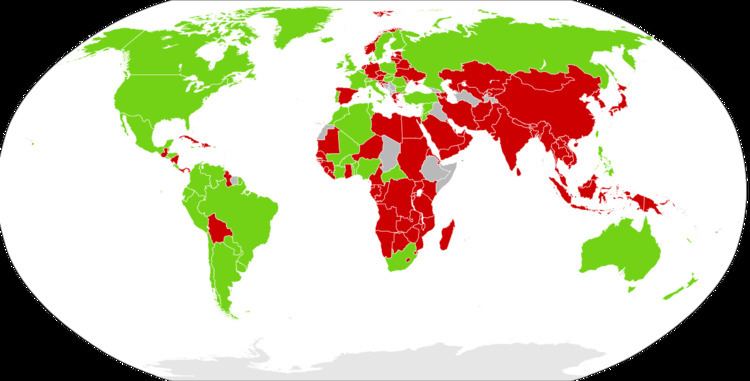 | ||
Immigration law refers to national government policies controlling the immigration and deportation of people, and other matters such as citizenship. Immigration laws vary from country to country, as well as according to the political climate of the times, as sentiments may sway from the widely inclusive to the deeply exclusive of new immigrants.
Contents
- In the United States
- Control measures
- Comparison of immigration visa categories by country or territory
- References
Immigration law regarding the citizens of a country is regulated by international law. The United Nations International Covenant on Civil and Political Rights mandates that all countries allow entry to its own citizens.
Certain countries may maintain rather strict laws which regulate both the right of entry and internal rights, such as the duration of stay and the right to participate in government. Most countries have laws which designate a process for naturalization, by which foreigners may become citizens.
In the United States
During the colonial period, independent colonies created their own immigration laws. The first law governing the naturalization of foreigners was the Naturalization Act of 1790. The 1882 Chinese Exclusion Act was passed to stop the immigration of Chinese people. The Emergency Quota Act of 1921 and the Immigration Act of 1924 put a quota on how many immigrants were permitted, based on nationality and the numbers of persons who had immigrated in previous years. The Immigration and Nationality Act of 1952 led to the creation of the Immigration and Naturalization Service.
The Department of Homeland Security, which replaced the Immigration and Naturalization Service, enforces immigration laws. The United States allows more than 1 million undocumented immigrants to become Legal Permanent Residents every year. The United States also issues more Visas than any other country in the world.
Visas in the United States can be broadly separated into two categories: immigrant visas, and non-immigrant visas. The former are subject to "per country-caps", whereas the latter is not. Most non-immigrant visas are for work purposes, and usually require an offer of employment from a US employer. Such immigration may involve restrictions such as a labor certification to ensure that no American workers are able to fill the role of the job. Other categories include student, family and tourist visas. Each visa category is further divided into numerous subcategories; the large number of specific categories has been recommended as a main area for comprehensive immigration reform.
Control measures
To control immigration, many countries set up customs at entry points. Some common location for entry points are airports and roads near the border. At the customs department, travel documents are inspected. Some required documents are a passport, an international certificate of vaccination and an onward ticket. Sometimes travelers are also required to declare or register the amount of money they are carrying.
Comparison of immigration visa categories by country or territory
This section is an attempt to classify and bring together information about immigration legislation on a number of countries with high immigration.
